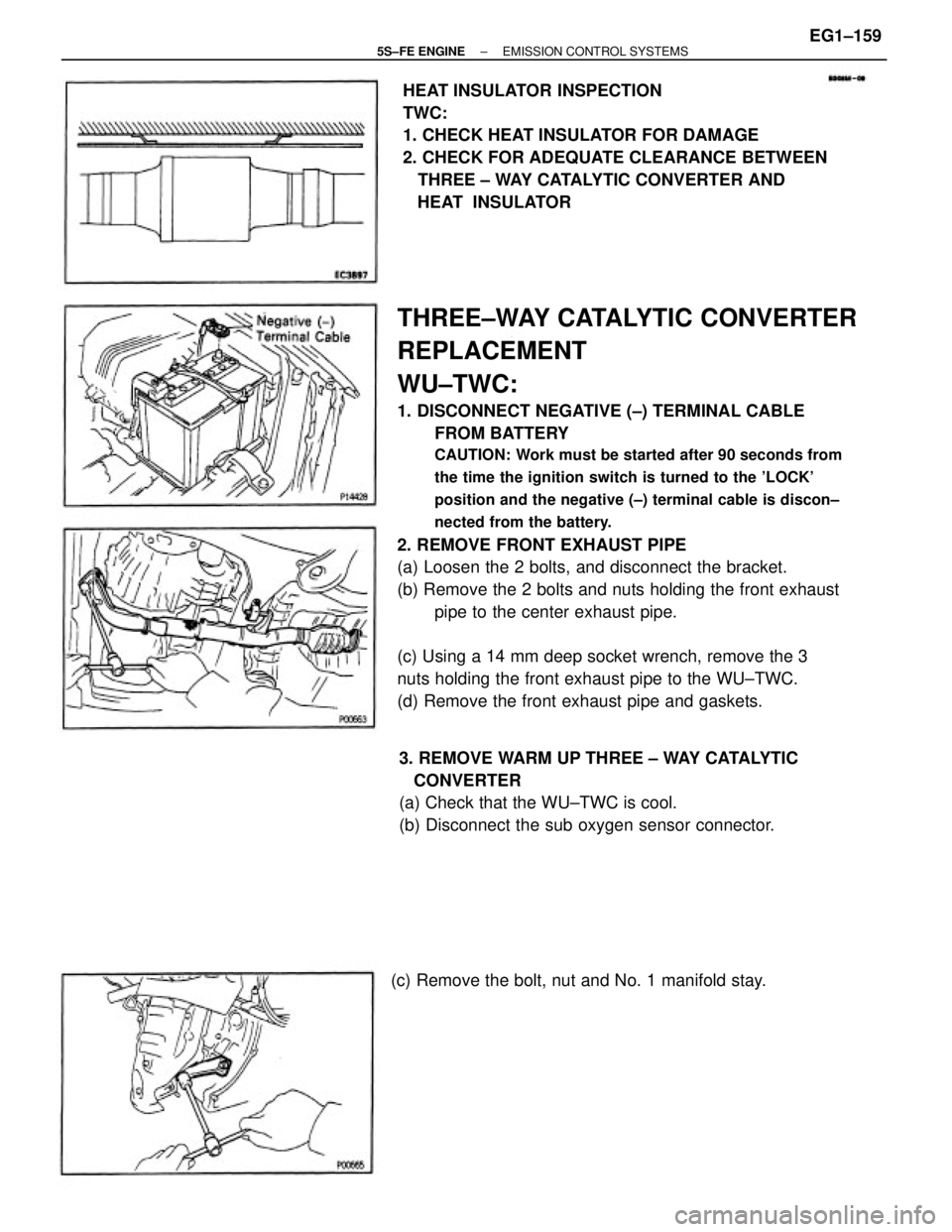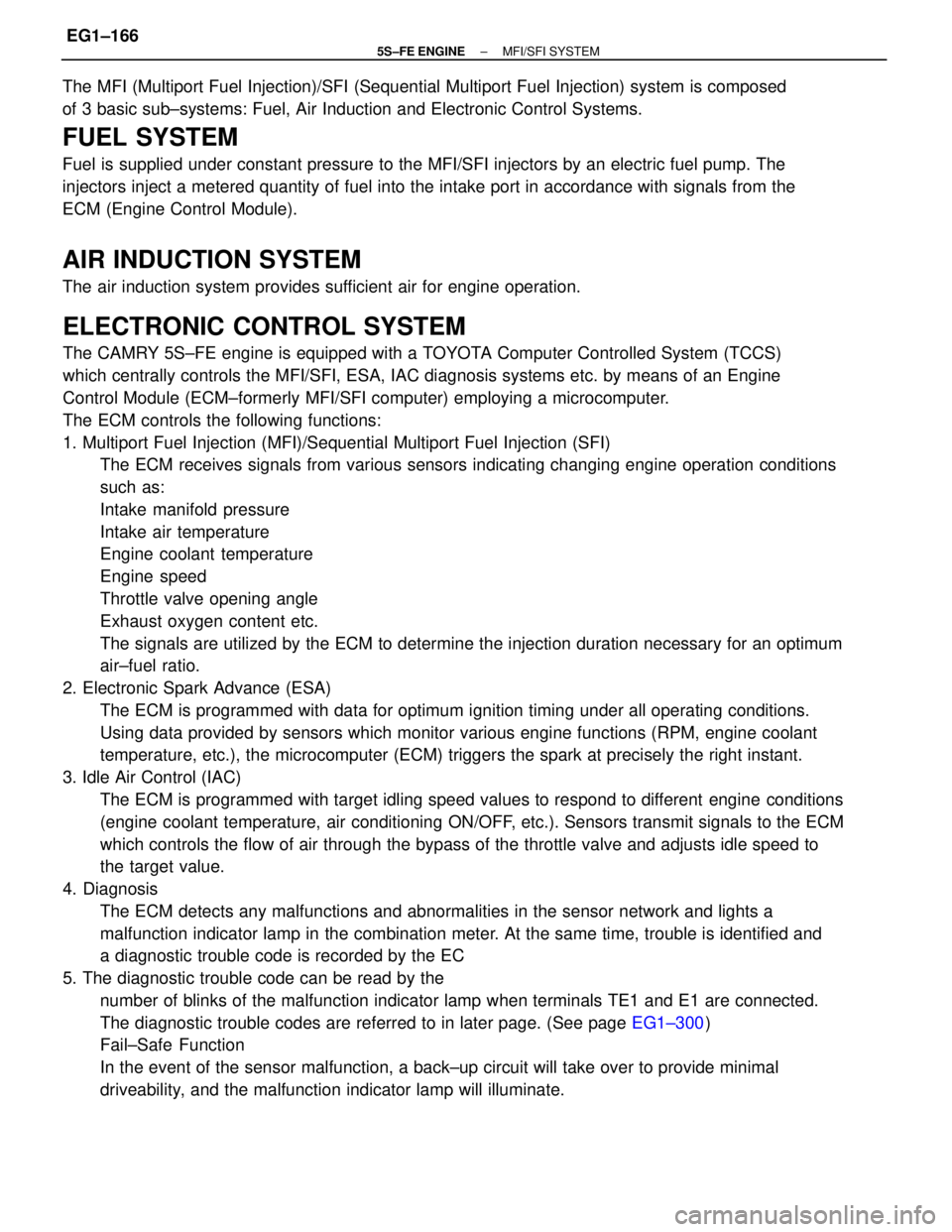Page 92 of 4770

5. REMOVE AIR CLEANER CAP, RESONATOR AND
AIR CLEANER HOSE
(a) Disconnect the intake air temperature sensor connec±
tor.
(b) California only:
Disconnect the air hose from the air cleaner hose.
(c) Loosen the air cleaner hose clamp bolt.
(d) Disconnect the 4 air cleaner cap clips.
(e) Disconnect the air cleaner hose from the throttle
body, and remove the air cleaner cap together with
the resonator and air cleaner hose.
6. REMOVE GENERATOR (See page CH±10)
7. REMOVE DISTRIBUTOR
(See page IG±13 end 32)
CYLINDER HEAD REMOVAL
(See Components for Removal and Installation)
1. DISCONNECT NEGATIVE (±) TERMINAL CABLE
FROM BATTERY
CAUTION: Work must be started after 90 seconds from
the time the ignition switch is turned to the ªLOCKº
position and the negative (±) terminal cable is discon±
nected from the battery.
2. DRAIN ENGINE COOLANT
3. A/T:
DISCONNECT THROTTLE CABLE FROM
THROTTLE BODY
4. DISCONNECT ACCELERATOR CABLE FROM
THROTTLE BODY
8. DISCONNECT FRONT EXHAUST PIPE
(a) Loosen the 2 bolts, and disconnect the bracket.
(b) Using a 14 mm deep socket wrench, remove the 3
nuts holding the front exhaust pipe to the WU±TWC.
(c) Disconnect the front exhaust pipe and gaskets.
± 5S±FE ENGINEENGINE MECHANICALEG1±42
Page 132 of 4770
37. A/T:
CONNECT AND ADJUST THROTTLE CABLE
38. CONNECT AND ADJUST ACCELERATOR CABLE
39. FILL WITH ENGINE COOLANT
Capacity:
6.3 liters (6.7 US qts, 5.5 Imp. qts)
40. CONNECT NEGATIVE (±) TERMINAL CABLE TO
BATTERY
41. START ENGINE AND CHECK FOR LEAKS
42. ADJUST IGNITION TIMING
(See page IG ±19 and 38)
Ignition timing:
10� BTDC @ idle
(w/ Terminals TO and E1 connected)
43. PERFORM ROAD TEST
Check for abnormal noise, shock, slippage, correct shift
points and smooth operation.
44. RECHECK ENGINE COOLANT LEVEL AND OIL
LEVEL
± 5S±FE ENGINEENGINE MECHANICALEG1±82
Page 135 of 4770

ENGINE REMOVAL
1. DISCONNECT NEGATIVE (±) TERMINAL CABLE
FROM BATTERY
CAUTION: Work must be started after 90 seconds from
the time the ignition switch is turned to the 'LOCK'
position and the negative (±) terminal cable Is discon±
nected from the battery.
2. REMOVE BATTERY AND TRAY
3. REMOVE HOOD
4. REMOVE ENGINE UNDER COVER
5. DRAIN ENGINE COOLANT
6. DRAIN ENGINE OIL
7. DISCONNECT ACCELERATOR CABLE FROM
THROTTLE BODY
8. A/T:
DISCONNECT THROTTLE CABLE FROM
THROTTLE BODY
9. REMOVE AIR CLEANER ASSEMBLY, RESONATOR
AND AIR CLEANER HOSE
(a) Disconnect the intake air temperature sensor connec±
tor.
(b) California only:
Disconnect the air hose from the air cleaner hose.
(c) Loosen the air cleaner hose clamp bolt.
(d) Disconnect the 4 air cleaner cap clips.
(e) Disconnect the air cleaner hose from the throttle
body, and remove the air cleaner cap together with
the resonator and air cleaner hose.
(f) Remove the element.
(g) Remove the 3 bolts and air cleaner case.
10. w/ CRUISE CONTROL SYSTEM:
REMOVE CRUISE CONTROL ACTUATOR
(a) Remove the actuator cover.
(b) Disconnect the actuator connector.
(c) Remove the 3 bolts, and disconnect the actuator with
the bracket.
11. REMOVE RADIATOR
± 5S±FE ENGINEENGINE MECHANICALEG1±85
Page 136 of 4770
(c) Disconnect the following connectors:
(1) Igniter connector
(2) California only:
Ignition coil connector
(3) Noise filter connector
(4) 2 ground straps from LH fender apron
(5) Connector from LH fender apron 12. DISCONNECT WIRES AND CONNECTORS
(a) Remove the engine relay box, and disconnect the 5
connectors.
(b) Connector from LH fender apron
(6) Data link connector 1
(7) 2 ground straps from RH fender apron
(d) Disconnect the MAP sensor connector.
13. DISCONNECT HEATER HOSES
14. DISCONNECT FUEL RETURN HOSE
CAUTION: Catch leaking fuel in a container.
± 5S±FE ENGINEENGINE MECHANICALEG1±86
Page 182 of 4770
(d) Connect the following connectors:
(1) Igniter connector
(2) California only:
Ignition coil connector
(3) Noise filter connector
(4) 2 ground straps from LH fender apron
(5) Connector from LH fender apron 24. CONNECT WIRES AND CONNECTORS
(a) Connect the 5 connectors to the relay box.
(b) Connectors from LH fender apron.
(c) Install the engine relay box. 21. CONNECT FUEL INLET HOSE
Torque: 29 N±m (300 kgf±cm, 22 ft±lbf)
22. CONNECT FUEL RETURN HOSE
23. CONNECT HEATER HOSES
± 5S±FE ENGINEENGINE MECHANICALEG1±132
Page 209 of 4770

THREE±WAY CATALYTIC CONVERTER
REPLACEMENT
WU±TWC:
1. DISCONNECT NEGATIVE (±) TERMINAL CABLE
FROM BATTERY
CAUTION: Work must be started after 90 seconds from
the time the ignition switch is turned to the 'LOCK'
position and the negative (±) terminal cable is discon±
nected from the battery.
2. REMOVE FRONT EXHAUST PIPE
(a) Loosen the 2 bolts, and disconnect the bracket.
(b) Remove the 2 bolts and nuts holding the front exhaust
pipe to the center exhaust pipe.
(c) Using a 14 mm deep socket wrench, remove the 3
nuts holding the front exhaust pipe to the WU±TWC.
(d) Remove the front exhaust pipe and gaskets.HEAT INSULATOR INSPECTION
TWC:
1. CHECK HEAT INSULATOR FOR DAMAGE
2. CHECK FOR ADEQUATE CLEARANCE BETWEEN
THREE ± WAY CATALYTIC CONVERTER AND
HEAT INSULATOR
3. REMOVE WARM UP THREE ± WAY CATALYTIC
CONVERTER
(a) Check that the WU±TWC is cool.
(b) Disconnect the sub oxygen sensor connector.
(c) Remove the bolt, nut and No. 1 manifold stay.
± 5S±FE ENGINEEMISSION CONTROL SYSTEMSEG1±159
Page 216 of 4770

ELECTRONIC CONTROL SYSTEM
The CAMRY 5S±FE engine is equipped with a TOYOTA Computer Controlled System (TCCS)
which centrally controls the MFI/SFI, ESA, IAC diagnosis systems etc. by means of an Engine
Control Module (ECM±formerly MFI/SFI computer) employing a microcomputer.
The ECM controls the following functions:
1. Multiport Fuel Injection (MFI)/Sequential Multiport Fuel Injection (SFI)
The ECM receives signals from various sensors indicating changing engine operation conditions
such as:
Intake manifold pressure
Intake air temperature
Engine coolant temperature
Engine speed
Throttle valve opening angle
Exhaust oxygen content etc.
The signals are utilized by the ECM to determine the injection duration necessary for an optimum
air±fuel ratio.
2. Electronic Spark Advance (ESA)
The ECM is programmed with data for optimum ignition timing under all operating conditions.
Using data provided by sensors which monitor various engine functions (RPM, engine coolant
temperature, etc.), the microcomputer (ECM) triggers the spark at precisely the right instant.
3. Idle Air Control (IAC)
The ECM is programmed with target idling speed values to respond to different engine conditions
(engine coolant temperature, air conditioning ON/OFF, etc.). Sensors transmit signals to the ECM
which controls the flow of air through the bypass of the throttle valve and adjusts idle speed to
the target value.
4. Diagnosis
The ECM detects any malfunctions and abnormalities in the sensor network and lights a
malfunction indicator lamp in the combination meter. At the same time, trouble is identified and
a diagnostic trouble code is recorded by the EC
5. The diagnostic trouble code can be read by the
number of blinks of the malfunction indicator lamp when terminals TE1 and E1 are connected.
The diagnostic trouble codes are referred to in later page. (See page EG1±300)
Fail±Safe Function
In the event of the sensor malfunction, a back±up circuit will take over to provide minimal
driveability, and the malfunction indicator lamp will illuminate. The MFI (Multiport Fuel Injection)/SFI (Sequential Multiport Fuel Injection) system is composed
of 3 basic sub±systems: Fuel, Air Induction and Electronic Control Systems.
FUEL SYSTEM
Fuel is supplied under constant pressure to the MFI/SFI injectors by an electric fuel pump. The
injectors inject a metered quantity of fuel into the intake port in accordance with signals from the
ECM (Engine Control Module).
AIR INDUCTION SYSTEM
The air induction system provides sufficient air for engine operation.
± 5S±FE ENGINEMFI/SFI SYSTEMEG1±166
Page 219 of 4770
The control system consists of sensors which detect various engine conditions, and a ECM which
determines the injection volume (timing) based on the signals from the sensors.
The various sensors detect the intake air pressure, engine speed, oxygen density in the exhaust
gas, engine coolant temperature, intake air temperature and atmospheric pressure etc. and
convert the information into an electrical signal which. is sent to the ECM. Based on these signals,
the ECM calculates the optimum ignition timing for the current conditions and operates the
injectors.
The ECM not only controls the fuel injection timing, but also the self diagnostic function which
records the occurrence of a malfunction, ignition timing control, idle speed control and EGR
control.
ELECTRONIC CONTROL SYSTEM
± 5S±FE ENGINEMFI/SFI SYSTEMEG1±169